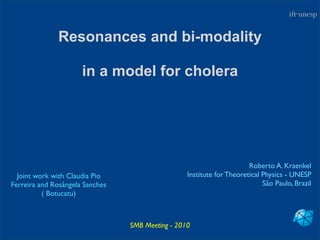
Resonances and bi-modality in a model for cholera
- 1. ift-unesp Resonances and bi-modality in a model for cholera Roberto A. Kraenkel Joint work with Claudia Pio Institute for Theoretical Physics - UNESP Ferreira and Rosângela Sanches São Paulo, Brazil ( Botucatu) SMB Meeting - 2010
- 4. ift-unesp Cholera •Water-borne disease
- 5. ift-unesp Cholera •Water-borne disease •Etiological agent: Vibrio Cholerae
- 6. ift-unesp Cholera •Water-borne disease •Etiological agent: Vibrio Cholerae •Symptoms vary greatly, from asymptomatic to intense diarrhea
- 7. ift-unesp Cholera •Water-borne disease •Etiological agent: Vibrio Cholerae •Symptoms vary greatly, from asymptomatic to intense diarrhea •Most important transmission route: environmental-to-human
- 8. ift-unesp Cholera •Water-borne disease •Etiological agent: Vibrio Cholerae •Symptoms vary greatly, from asymptomatic to intense diarrhea •Most important transmission route: environmental-to-human •3–5 million cholera cases and 100 000–120 000 deaths due to cholera every year
- 9. ift-unesp
- 11. ift-unesp Endemic Cholera • Cholera is endemic in many regions, mainly in the Indian sub-continent, Asia, Africa & Latin America
- 12. ift-unesp Endemic Cholera • Cholera is endemic in many regions, mainly in the Indian sub-continent, Asia, Africa & Latin America • Usually displays one or two annual peaks
- 13. ift-unesp Endemic Cholera • Cholera is endemic in many regions, mainly in the Indian sub-continent, Asia, Africa & Latin America • Usually displays one or two annual peaks • Spatial correlation suggests environmental causes for periodicity.
- 14. Models of Cholera ift-unesp epidemics
- 15. Models of Cholera ift-unesp epidemics • First model proposed by Capasso(1979)
- 16. Models of Cholera ift-unesp epidemics • First model proposed by Capasso(1979) • Two equations - infected individuals & aquatic population of V. Cholerae
- 17. Models of Cholera ift-unesp epidemics • First model proposed by Capasso(1979) • Two equations - infected individuals & aquatic population of V. Cholerae
- 18. Models of Cholera ift-unesp epidemics • First model proposed by Capasso(1979) • Two equations - infected individuals & aquatic population of V. Cholerae • Model by Codeço : S I R B ( susceptibles, infected, removed and bacteria)
- 19. Codeço Model ift-unesp
- 20. Codeço Model ift-unesp C.T. Codeço BMC Infectious Diseases (2001) 1:1
- 21. Codeço Model ift-unesp C.T. Codeço BMC Infectious Diseases (2001) 1:1 Epidemic and Endemic solutions are possible
- 22. Codeço Model ift-unesp C.T. Codeço BMC Infectious Diseases (2001) 1:1 Epidemic and Endemic solutions are possible Easily incorporates seasonality through time-dependence in the parameters: endemic peaks, once a year, no bi-modal solutions.
- 24. ift-unesp Extended model • incorporates loss of immunity
- 25. ift-unesp Extended model • incorporates loss of immunity • seasonality
- 26. ift-unesp Extended model • incorporates loss of immunity • seasonality • control mechanisms
- 27. ift-unesp
- 28. ift-unesp
- 29. ift-unesp
- 30. ift-unesp Results • If no seasonality and control are present endemic equilibrium is stable if R_0 > 1
- 31. ift-unesp Effects of seasonality • Approach to endemic equilibrium is through damped oscillations • Seasonal forcing introduces sustained oscillations. • The amplitude of oscillations depends on and .
- 33. ift-unesp Resonance approach • plot the local maximum in terms of p
- 34. ift-unesp Resonance approach • plot the local maximum in terms of p
- 35. ift-unesp Resonance approach • plot the local maximum in terms of p Resonance peak
- 36. ift-unesp Resonance approach • plot the local maximum in terms of p Resonance peak bimodality
- 39. ift-unesp Solutions uni- modal
- 40. ift-unesp Solutions uni- bi- modal modal
- 43. ift-unesp Control mechanisms hand- washing, education..
- 44. ift-unesp Control mechanisms hand- washing, education.. sanitation
- 45. ift-unesp Control mechanisms hand- washing, education.. water treatment sanitation
- 46. ift-unesp Control mechanisms vaccination hand- washing, education.. water treatment sanitation
- 47. ift-unesp Control mechanisms vaccination hand- washing, education.. water treatment sanitation efficiency index
- 48. ift-unesp Control mechanisms vaccination hand- washing, education.. water treatment sanitation efficiency index model allows to obtain critical values for eradication
- 49. eradication thresholds ift-unesp hand-washing, water treatment education.. continous continous no eradication with periodic no eradication with periodic sanitation vaccination continous no eradication with periodic periodic
- 50. ift-unesp Thanks for your attention Roberto Kraenkel kraenkel@ift.unesp.br http://www.ift.unesp.br/users/kraenkel
